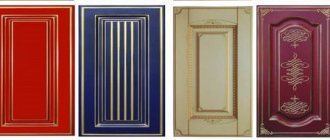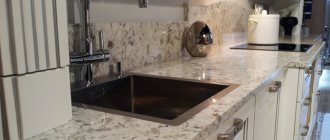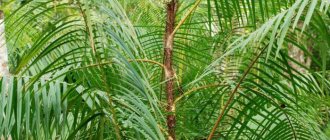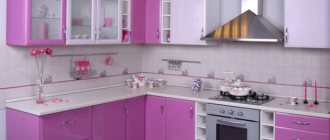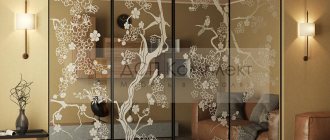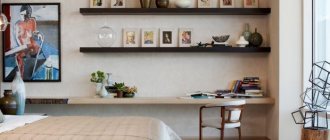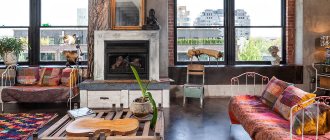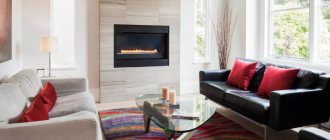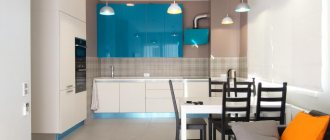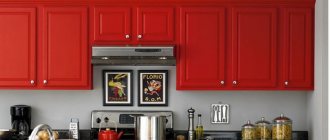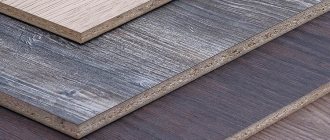What is it and what does it consist of?
MDF is a medium density fibreboard. The two most common forms of material are panels and sheets. Quality and service life do not depend on the shape.
It is made from small sawdust, just like chipboard. But in the case of MDF, smaller sawdust is used, which allows you to create a more dense and reliable structure. Correct slabs are smooth, even and uniform, so they are easy to work with - veneering, processing and milling.
The holes are made without problems, and without crumbs and shavings. You can even apply a complex pattern. In its behavior, MDF is similar to wood, but has a more affordable price.
The material is not afraid of water and can withstand up to 80% humidity, so it is often used in the kitchen or even in the bathroom. Note that real wood can only withstand 60% humidity.
Although MDF can be called a very durable material, it is also flexible. It produces round objects without any problems. The photo shows the panel in section:
What does this abbreviation mean?
It is simply impossible to decipher the abbreviation in Russian, since the name was simply taken and copied from English - MDF, or Medium Density Fiberboard, which translates as medium density fiber board. If desired, you can add a small clarification: wood fiber.
There is no fundamental difference in which decoding to use - it’s a matter of habit. But since the very appearance of MDF took place in 1966 in the USA, therefore the English name is preferred. This building material reached Russia only 31 years later, namely in 1997.
At the moment, the People's Republic of China is considered the leader in MDF production.
Description of building material
Fiberboard, which has an average density, is considered an excellent and inexpensive substitute for natural wood. At the same time, over the years of production, manufacturers have improved not only the production method and composition, but also found optimal dimensions that allow MDF to be used very widely.
Each manufacturer, naturally, indicates that MDF is an environmentally friendly material. The main proof of this is that wood derivatives and natural binders are used to produce MDF. There are no restrictions on the composition of the stove for indoor use.
A few words about MDF:
Production technology
Modern production makes it possible to create an almost identical copy of the natural structure of wood. The finely dispersed fraction of wood has its own operating characteristics, due to which it has many advantages. But let's start with the stages of MDF production :
- Preparation . The logs are cleared of bark, crushed into chips and sorted, clearing them of debris and dirt. Heat by steam.
- Formation of fibers. The resulting chips are crushed as much as possible in a special machine - a refiner. This is necessary to release the natural resin from MDF - lingin, which will later act as glue.
- Formation of the slab. The prepared mass is sent to the machine, where it is laid in the form of a sheet using rollers. This is where pre-compression occurs.
- Pressing. At this stage, the chips finally take on their future shape. After pressing, the material must cool for half an hour. The unsanded sheet is then processed until smooth.
What are the benefits of MDF furniture?
The material is very popular for making furniture, as it has the following parameters:
- resistance to temperature and moisture;
- ease;
- ease of installation;
- prevalence;
- strength, resistance to wear and mechanical stress;
- good level of sound insulation;
- resistance to microorganisms;
- ease of care;
- durability;
- reduced flammability;
- low cost.
In addition, MDF panels also look beautiful, so they are often used for design solutions. But there are also negative sides. These include:
- low strength of thin sheets;
- limited choice of textures and colors;
- possible reduction in space due to the installation of a frame under the panels (when covering walls).
Furniture material MDF
As a result of its uniform density and ease of machining, sanded MDF is used in most industrial and household applications. For example, this structural material with a thickness of 6-8 mm is used for finishing walls and making ceiling structures. Facades for various furniture and profiled tabletops are made from slabs 16-30 mm thick.
In the process of manufacturing carpentry, partitions and the main structural components of furniture, sanded MDF from 30 to 60 mm is used, which shows excellent physical properties during drilling, milling, and creating grooves.
Specifications
Due to some of its characteristics, MDF sometimes stands even higher than wood. One of these features is that the slab can be bent at any angle, giving the furniture an unusual shape. A medium-hard board can withstand pressure up to 15 MPa. In addition, fungus and other pests simply will not settle in such material.
There are certain standards that companies must adhere to when making the material. For example, the density level - it should be from 720 to 980 kg/m3. Hence MDF boards are divided into two types :
- LDF - low density board (up to 600 kg/m3);
- HDF - high density board (from 800 kg/m3).
Of course, HDF boards are of higher quality, but they will also cost more.
There are also several types of slabs based on quality.
| Variety | Description |
| I | An excellent choice - homogeneous, smooth products, no chips, scratches, roughness or other defects |
| II | Minor defects are allowed - gouges and scratches up to 2 cm long and up to 0.03 mm deep, small chips on the edges, slight roughness |
| III | Instances with pronounced defects - scratches, damage, chips, roughness. This option is suitable for construction purposes. |
Some designers recommend specifying the emission class. This characteristic is responsible for whether the material will release formaldehyde, and in what quantity. According to GOST there are only two emission classes :
- E1;
- E2.
The first class is allowed even for use in children's premises, since such a panel cannot cause any harm. It is these types of specimens that are most often found in construction stores.
Comparative characteristics
MDF boards are easy to mill and process.
Depending on the type of coating, the following types are distinguished:
- laminated with PVC film, melamine, tarred paper of different textures;
- painted ones are glossy, matte with the use of protective paints and varnishes;
- veneered with a sticker of a thin cut of natural wood.
The coating of laminated particle boards is made of moisture-resistant PVC film (0.05 - 0.8 mm) and varnish. The layer is applied by gluing or lamination (melting at high temperatures). Depending on the processing method and quality, three types of wood-based products are distinguished. The first assumes a complete absence of defects, and the third is of low quality.
Material care
It is important to avoid exposure to high temperatures and humidity.
There are general care rules and differences. Both artificial finishing materials do not tolerate steam and temperatures above +75°C . In this case, the top finishing layer may peel off.
There are rules that must be followed for one of the types, but for the other their compliance does not matter:
- The influence of sunlight is more dangerous for wood-based panels. Products made from the finely dispersed fraction will also fade, but will retain their original color longer.
- Humidity is more dangerous for laminated chipboard products, since boards are often produced with untreated ends. Moisture-resistant MDF strips with sides covered with PVC film can withstand even direct exposure to water for some time.
Clean the slabs with a damp sponge and a small amount of detergent.
Strength and Density
Panels made from chips have a density of 740 - 600 kg/m³, while thin slabs are more compact, and with increasing thickness the density decreases.
Fine-grained products have a constant density for sheets of any thickness - 780±20 kg/m³. Strength indicators of both types:
- MDF. Bending strength - 18 - 23 N/mm², tensile strength - 0.55 - 0.65 N/mm², elastic modulus - 2100 - 2700 N/mm².
- Chipboard. Bending strength - 14 - 18 N/mm², tensile strength - 0.25 - 0.4 N/mm², elastic modulus - 1800 - 2600 N/mm².
MDF is also produced in low density (LDF marking), the figure can reach 200 – 600 kg/m³. In the category of finely dispersed panels, there are products with increased density (NDF), the desired value of which exceeds 800 kg/m³.
Moisture resistance
The resistance to water of finely dispersed products exceeds that of chipboards with a laminated coating. This is due to smaller particles in the material and a different quality of the binder material. The type of finishing film also plays a role in protecting the material from moisture.
Laboratory research data on material wetting during the day:
- finely dispersed slabs increase in thickness by 10 - 17% in 24 hours;
- laminated particleboard panels become 22% thicker than the original value.
The waterproofing of the finishing layer plays a role. If the cladding is placed on a floor or wall that is saturated with moisture from the foundation, the installation of a protective membrane is required.
Environmental friendliness
Fine-grained slabs do not contain synthetic binder resins, which can be released into the room air. Polymer formaldehyde components degrade during use, so people are at risk by inhaling them.
To differentiate by degree of emission there are classes:
- E1 - the formaldehyde content is allowed to be no more than 8 mg per cubic meter of dry material. The air should not contain more than 0.124 mg per 1 m³ (chamber determination method). The gas analytical method provides for no more than 5 mg within 3 days from the moment the panel is released or no more than 3.5 mg/m²·hour.
- E2 - category includes materials that contain 8–30 mg of formaldehyde per cubic meter of dry mass. Free release into the surrounding atmosphere should not exceed 0.124 mg per 1 m³, or 3.5 – 8.0 mg/m²·hour, or 5 – 12 mg within three days from the end of production.
From MDF and laminated chipboard, the first material is more suitable for finishing housing.
Durability
This operational parameter largely depends on the conditions of use of the material. The slabs can be used to decorate walls or be used as a kitchen countertop. In the first case, the cladding will last longer, but in the second, everything will depend on aggressive factors: grease, hot drops.
MDF panels are more resistant to high temperatures; polyvinyl chloride, plastic and veneer layers contribute to this. Wood-shaving products are less dense, so they are more likely to become unusable.
Question to the expert
How to visually distinguish MDF from laminated chipboard when buying sheets in a store?
You need to look at the end edge of the sheet. The finely dispersed fraction looks homogeneous in the section; individual particles are invisible in it. The laminated particle board shows large chips at the end. The composition of the material is specified in the certificate of conformity, which the manufacturer issues when releasing the batch.
Types of panels
Another important nuance for choosing an MDF panel is its release form . They are distinguished:
- Rack type. It is a very elongated rectangle 2–3 meters high and only 15–25 centimeters wide. Such panels are used for ceilings or walls, so they have a lock. When choosing, you should pay attention to it: the lock must be no shorter than 5 mm - otherwise it can simply break off.
- Tile type. The maximum size of such a panel for a wall is one meter per meter. They can be either square or rectangular. They are most often mounted on a frame or on a hidden fastening system (if available).
- Sheet material . Rarely used in decoration, but useful in making furniture. Although the scope for imagination is not limited.
MDF or chipboard. What's best for children?
When choosing a children's room, we are, of course, concerned about the safety and environmental friendliness of future furniture. Of course, a lot depends on the character of the child and the period for which you purchase furniture. For a long time or, for example, until the moment when the child goes to gnaw on the granite of science.
If you have a hooligan boy growing up who conducts experiments on everything he sees, then MDF is your option. And if you have a gentle and neat excellent student growing up, then you may well make a choice in favor of chipboard.
Visit any of our Mr.Doors furniture showrooms with your children! We guarantee that you will experience a lot of positive emotions and get an answer to every question you have! You will be pleasantly pleased with professionalism, willingness to help, individual approach and high-quality service.
Author: Natalya Pavlova
Classification by finish
After manufacturing, the material has a gray-brown color, so it is problematic to fit it into the interior. The surface can also be refined. We will now look at several ways to do this.
Veneering
The slab is covered with veneer, that is, a thin cut of natural wood. Of course, after this the surface cannot be distinguished from an array, but in addition to this, the quality also increases. The veneer is attached with glue, and experts call this the beautiful word “veneering”.
This method of decoration gives the facades a very realistic look. This is not a cheap pleasure, but the following advantages appear:
- moisture resistance;
- resistance to warping;
- do not dry out.
Fine-line
This finish can be called a subtype of the original veneer. Fine-line is also called eco-veneer, since sections of inexpensive and soft wood, such as poplar, are used.
Thanks to this feature, such a material is much cheaper than “real” veneer, but still perfectly conveys the grain of the wood.
Stone veneer
Another type of veneering. In this case, the thinnest possible cut of natural stone is used - about 1-3 mm. Sometimes polyester resins are used, but they look like natural stone.
This surface is resistant to any conditions, even mechanical tests. The only drawback is the small selection of colors.
Plastic
This type of finishing is most often used in furniture production. The idea is simple: a very thin layer of plastic or acrylic is glued onto an MDF panel. In this case, it is necessary to monitor the quality of edge protection - it can be either plastic or aluminum. Without them, the façade will not last long, since the panels will begin to come off and dirt will accumulate underneath them.
Since plastic is used only as a top layer, the question of which is better—a kitchen made of MDF or plastic—is not even worth asking. They go inseparably. We should only talk about comparing finishing materials for MDF, for example, enamel or plastic, acrylic or veneer.
PVC film
If the chosen surface is not a flat one, but one with a pattern, then the slab is first milled and then covered with a film under pressure so that the latter fits into all the recesses of the pattern. This type of panel is also called laminated.
The film can imitate a wood structure, repels dust and increases the panel's resistance to mechanical stress. The surface can be either matte or glossy of any shade.
The main advantages of film MDF include:
- strength;
- resistance to moisture and ultraviolet radiation;
- hygiene;
- Possibility of chemical care;
- Dirt resistance.
High gloss film
The essence of high-gloss film is that it is applied seamlessly - simultaneously to the front facade and side edges. Due to this application, the furniture turns out to be very beautiful, smooth, even and shiny. This service is not yet so popular, so the choice of colors for furniture is limited.
Coloring
After painting, the slab becomes more protected and acquires a pleasant shine. Painting can be either automatic or manual. Enamel, UV varnish or other flexible paint options are suitable. This coating is not as stable as previous analogues, but still protects against previous factors.
The same cannot be said about special enamel paint. It is applied in several thin layers and even protects from mechanical stress. It is also not afraid of moisture and pollution.
But there is one peculiarity - such a coating should never be rubbed with hard sponges: noticeable scratches will remain. Such kitchens most often have a strong gloss. Matte options are more expensive as they require additional processing. But it is easier to care for such a coating.
We recommend reading: Which kitchen is better to choose, glossy or matte?
Soft Touch
One of the varieties of matte finish is Soft Touch. This is a special paint based on rubber varnish. There are no fingerprints or scratches on it, and it does not glare in the sun, creating the impression of a velvet surface. It is very practical to clean, since drops of fat and other dirt are simply not visible.
MDF panels
There are:
- laminated. This material is the most popular. To obtain LMDF, a PVC film is applied to the board, which can imitate the structure of solid wood. In addition, it repels dust and increases the panel’s resistance to mechanical stress.
- painted panels are produced by painting slabs with high-quality coatings that are characterized by resistance to chemical reagents. The surface after painting has a pleasant shine and becomes more protected.
- veneered panels – finished with veneer of expensive types of timber. Such products can be given different shades.
The production of MDF boards today is a highly technical and modern process. The use of natural raw materials in production suggests that the final product is environmentally friendly, while the process of its production is not labor-intensive.
Comparison with chipboard/chipboard
Chipboard is also made from wood chips. To glue it and give it the desired shape, resins are used, which do not always meet environmental requirements, so such furniture is undesirable for use in the kitchen, although it is very popular.
Due to such differences in the production process, chipboards are not as dense: a maximum of 650 kg/m3, which means they are more susceptible to the effects of water and steam, and are not so durable in general.
For example, when wet, a chipboard board actively absorbs moisture and can increase in volume by about 30%. In this case, we can distinguish laminated chipboard - that is, ordinary chipboard, which is covered with a film on top, or laminated. This material is not afraid of moisture due to the protective top layer, so it is often used to create budget countertops.
But you should understand that if the top layer deteriorates or is damaged, the chipboard will immediately reveal all its shortcomings.
We wrote about what is better for the kitchen - MDF or chipboard >>>
MDF has the following advantages over chipboard:
- with equal thickness, MDF will be twice as strong;
- the ability to form reliefs of any complexity;
- easier to process;
- smoother surface;
- more environmentally friendly;
- not demanding on operating temperature.
But most kitchen furniture, including facades and countertops, are now made of chipboard. Such a set will not last long - about 10-15 years. But thanks to the low cost, this can be even more profitable than one set from an array for 40 years. If environmental friendliness is important, then it is better to choose MDF panels.
MDF or chipboard, which is better? Advantages and disadvantages…
Comparison with natural wood
Even over natural wood, MDF has advantages:
- equal density over the entire surface of the slab;
- absence of natural defects - for example, knots, voids, etc.;
- possibility of embossing and other special processing;
- resistance to microorganisms and fungi;
- the cost is 60–70% lower.
Solid wood furniture belongs to the expensive and elite category. Russian oak is valued more than others - it is also used for veneer.
The most budget option is birch or pine. Such a set will last 40 years or even more - the main thing is that you don’t get tired of it. But no matter how beautiful and prestigious such furniture may look, it is very sensitive to temperature changes and is also difficult to maintain. For these reasons, the array is now being replaced with veneered MDF.
Comparison with plywood
MDF also has advantages over plywood:
- absence of external and internal defects such as knots and holes from them, veneer overlaps, cracks, and so on;
- perfectly flat and smooth surface;
- no deviations in the width or length of the sheet;
- not afraid of exposure to steam;
- more favorable price.
But at the same time, plywood is more durable. This is due to the manufacturing process: solid wood is used for plywood, and only its fibers are used for MDF. It is not customary to use plywood for kitchen furniture or even backsplashes.
Comparison with fiberboard
Fiberboard is a material also made from wood chips. The difference from MDF is the use of synthetic resins to strengthen the wood board.
The plate is made by wet pressing, so its back is not smooth, but resembles a mesh from a brand on cottage cheese. This is not the best option for the kitchen, as dust may accumulate.
To better imagine this material, you need to remember the back wall of some cabinet - that rough material is fiberboard, or, as it is sometimes called, hardboard.
Fiberboard is not afraid of moisture and temperature changes, but at the same time it is also low in cost. But the manufacturing process itself does not allow making hardboard thick, so it cannot be used as a facade or countertop in the kitchen. The maximum is the back wall of the kitchen unit.
MDF or chipboard. What's best for the kitchen?
The kitchen is without a doubt the most important room in the house. The most significant events of our lives take place on it. With all this, this is not the best place for furniture. Judge for yourself: water, high temperature, greasy dust, hot steam and cleaning products are quite an aggressive living environment.
The frame of kitchen furniture is usually made of chipboard. This is due to the fact that the facades take the entire blow. They get all of the above.
If you are for durability, then you definitely need to choose MDF for your kitchen. It is highly moisture resistant, fireproof and easy to clean. You will be offered a wide choice of colors and finishes, however, it will cost more.
If you are short on funds, then choose chipboard. With careful use and careful care, it will also serve you faithfully. Don't forget to pay attention to the edges and find out what class the chipboard belongs to.
How to choose and buy panels?
The choice of MDF panel should be based on where it will be used - hence the focus on different characteristics. For example, painted panels are quite suitable for the kitchen, since they have increased resistance to moisture and steam. But this will still not be enough for the bathroom - only laminated materials (LMDF) are suitable here.
If any additional finishing work is planned on the furniture facade, then it is best to select veneered MDF. If it is necessary to decorate large spaces, ordinary tiled MDF will do.
It is important to pay attention to the manufacturer. Of course, as you can see above, the choice of domestic brands is wide, but foreign materials, for example, from Poland, Sweden and Germany, have the best reputation. But copies from China cannot boast of quality - they charge a price.
In any case, before purchasing, it is necessary to conduct a thorough inspection of the selected material for the kitchen:
- check the surface for smoothness and absence of chips;
- there should be no smell;
- the color should be uniform.
Such a thorough check is due to the fact that some unscrupulous manufacturers, under the guise of MDF, sell laminated chipboard panels, which are inferior in quality and strength.
The difference between MDF and other wood-containing materials
Modern construction at the stage of cladding and decoration practically does not involve the use of real wood. Instead, everything that contains its waste is actively used. In the production of furniture, at least those designed for the mass consumer, there is also no place for real wood. Instead, here and there, for example, chipboard is used.
What is the difference: chipboard, MDF, plywood, furniture board, lumber, veneer, you can watch the video:
What is better: chipboard or MDF and how they differ
Chipboard is sawdust that is pressed together with formaldehyde resins.
This material has a number of differences from MDF, the main ones are listed in the table:
| MDF | Chipboard |
| Contains no formaldehyde | Contains formaldehyde resin |
| Appearance allows use for decoration | Can only be used for rough work |
| Does not require additional cladding | Can be lined |
However, it is worth noting that chipboard is a fairly strong and water-resistant material that can hold nails under load.
The difference between laminated chipboard and MDF
But laminated chipboard (LDSP) is a sanded material that has a facing film. This is what makes laminated chipboard similar to MDF. The film is made of paper and melamine resin and it significantly increases the wear resistance of laminated chipboard.
If you compare this material with MDF, the main differences will be as follows:
| MDF | laminated chipboard |
| Environmentally friendly material | Contains harmful components |
| The material is classified as soft | Hard material |
| High price | Affordable price |
| Nice but not the greatest exterior | Wide variety of colors |
MDF is easy to process and is used even in luxury construction. But laminated chipboard has an increased degree of protection from harmful influences, which allows it to be used in kitchen and bathroom cladding, as well as in the production of furniture for these premises.
Which is better solid wood or MDF?
Often MDF can be used where solid wood can also be used. These materials, while fundamentally different, also have common features. The main one is that MDF can be used for facades, for example, a kitchen wall. Moreover, now it is one of the most popular materials in furniture production.
Solid wood, especially cedar, oak, and ash, is used extremely rarely when creating furniture sets. The first thing that prevents the use of such wood is the high price. Secondly, wood is a very heavy and sometimes capricious material.
If you compare MDF and array, you can create the following table:
| MDF | Solid wood |
| Environmentally friendly material, which also has a fairly wide variety of colors | Absolutely environmentally friendly material, unless, of course, the tree was grown in the Chernobyl zone |
| Easy to clean | Requires additional care |
| The surface of this material can be glossy or matte | The surface has an expensive, exclusive look |
| Bends well, but is susceptible to damage and loses color over time | The material must not be bent or rounded. Only geometrically correct shapes can be made from an array |
Both materials are moisture resistant and, with proper care, can look great and last a very long time.
Veneer or MDF
Veneer can be of at least three varieties: peeled, planed, sawn. And each of them is inferior in strength to MDF.
For comparison, you can see the table below:
| MDF | Veneer |
| Quite durable and durable material, the appearance of which remains unchanged for a long time | Exposed to sunlight, does not tolerate mechanical loads well |
| Looks expensive and beautiful | Has an attractive appearance |
| Completely ready to use | Can be varnished |
| Has a high price | It's quite expensive |
It is noteworthy that MDF can be veneered. And this improves its technical characteristics. Both materials are used for doors and in the manufacture of furniture.
Plastic or MDF
You can compare these materials only when it comes to creating panels for walls. The dimensions and appearance of plastic and MDF allow you to create practical, beautiful and durable panels. However, not everyone will be able to distinguish them by appearance.
However, the technical characteristics of the materials differ quite significantly:
| MDF | Plastic |
| Environmentally friendly | Contains harmful impurities |
| Lights up hard | Does not burn, but melts, releasing hazardous substances |
| It is moisture resistant, but with constant contact with water it will lose its qualities and ruin its appearance. | Indifferent to moisture, even in contact with water, will not change its qualities |
Plastic can even be used for cladding furniture and doors. The material belongs to the category of universal ones and many construction workers prefer it.
Medium Density Fiberboard is a modern material that manages to embody the advantages of natural wood, the quality of plastic surfaces and beauty that is suitable for many styles. MDF has a wide range of colors, can be used in various fields, and at a relatively high price, the consumer receives exceptionally high quality.
What can you make with your own hands from MDF?
At home, you can make almost any furniture and decoration from this material (set, table, chairs, apron, ceiling, etc.). The main thing is to have two things:
- good tool;
- skillful hands.
If these two components are found, then it’s just a matter of fantasy and imagination. Some craftsmen make their own kitchen sets from MDF - this results in excellent savings. An example of such amateur activities that can be done is in the photo.
Would you like to repeat something similar? For cutting MDF panels at home, a jigsaw with a suitable blade is best - this work is the easiest and fastest. If you don’t have a jigsaw, you can get by with a saw or even a grinder.
Interesting read: Painting and patination of MDF kitchen facades in 7 steps
Care
The performance qualities of MDF are quite high, so furniture or decoration does not require special or complex care. However, to extend service life and maintain a presentable appearance, the following rules should be followed:
- wipe with a clean and damp cloth;
- maintain the temperature at a level of 10 to 40 degrees;
- do not use solutions containing chlorine or acids;
- use soap solution;
- do not scratch, trying to tear something off, for example, with scissors or a knife;
- polish using special wax or silicone based products.
All these rules apply rather to kitchen facades. Caring for other MDF furniture most often comes down to wiping with a dry cloth.
